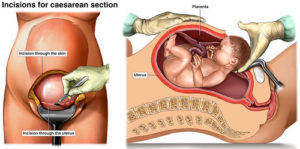A cesarean section is a surgical procedure to deliver a baby through a cut in the mother’s abdomen (tummy) and uterus (womb). There are several medical reasons why you might plan for a cesarean, or your medical team might decide it’s safest for you to have an emergency cesarean after labour begins.
Reasons you may need a Cesarean
The most common reasons for needing a cesarean are:
- Your baby is in the breech position (bottom first) and your doctor doesn’t recommend a vaginal breech birth
- Your baby is transverse (lying sideways) and can’t be turned by the doctor
- The umbilical cord is pinched or you have umbilical cord prolapse. This is when the umbilical cord slips into the vagina before the baby.
- You have twins and the first one is in the breech position
- Your placenta is partly or completely covering the cervix (opening to the womb)
- Your baby is in distress. This means he isn’t getting enough oxygen or his heartbeat may not be regular.
- You have an infection, like HIV or genital herpes. You can pass these infections to your baby during vaginal birth. So, a c-section is safer for your baby.
- You’ve had a c-section in the past or you’ve had other surgeries on your uterus (womb)
A cesarean might be planned if you develop pregnancy complications. But sometimes the need for a cesarean does not become clear until labour is underway. In an emergency, the baby may need to be delivered very quickly.
What is the procedure of a C – section (Cesarean)?

Image source – Pregnancy, Birth and Baby
Before surgery
To prepare for the operation, an IV will be placed in a woman’s arm or hand to give her the fluids and medications she’ll need during surgery. Her abdomen will be washed and her pubic hair may be clipped or trimmed.
A catheter (tube) is placed into a woman’s bladder to remove urine, and it will remain there for a day after the surgery.
Women are usually given a regional anesthetic, such as an epidural, which numbs the lower part of your body. This means you will get to be awake throughout the operation. Sometimes emergency cesareans must be done under general anesthetic, which means you won’t be conscious during birth.
During surgery
The obstetrician will make a cut through the wall of your abdomen usually low and across near the pubic hairline. If your baby needs to be delivered very quickly, the cut may be made vertically from just below the belly button to above the pubic bone. The doctor will then cut through the layers of fatty tissue and muscle and finally cut through the uterus.
The baby is delivered through the cuts. The doctor will clear the baby’s nose and mouth of fluids and clamp the umbilical cord. They will then remove the placenta and close the cuts with stitches or staples.
If you are awake, you will feel tugging and pulling but no pain. A screen will be put across your chest so you cannot see what is happening.
The operation takes about 30 to 40 minutes, with the baby usually born in the first 10 minutes. If you are awake, you will be able to see your baby immediately.
Once the delivery and afterbirth are completed, the cuts made to the mother’s uterus are repaired with stitches, which will eventually dissolve under the skin. The abdominal skin is closed with stitches or with staples, which will be removed before a woman leaves the hospital or goes to the maternity ward for recovering.
Recovery after C – section
It may take a woman up to 6 weeks to feel more like herself again after a cesarean.
Her abdomen will feel sore from the surgery and the skin and nerves in this area will need time to heal. Women will be given pain medications to take the edge off any post-surgical pain, and most women use these medications for about 2 weeks afterward, Bryant said.
One may also experience bleeding for about 4 to 6 weeks after a surgical birth. She is also advised to not have sex for a few weeks after her C-section and to also avoid strenuous activities, such as lifting heavy objects.
Benefits of having a C-section
A planned cesarean section also lowers the risk of birth injuries such as asphyxia (oxygen deprivation), shoulder dystocia, and fractures.
It may also reduce the risk of:
- Pain during the birth
- Heavy bleeding after the birth
- Any injury to the vagina
- Loss of bladder control
- Pelvic organ prolapse
Risks of having a C-section
Having a c-section can increase some risks to you and your baby. This doesn’t mean that these things will happen to you, but there may be a higher chance of them happening than if you had a vaginal birth.
Some of these risks are:
- Bleeding that leads to a blood transfusion or having the womb removed. (Although, this is uncommon and may be more likely if you had the problems with the placenta or bleeding during pregnancy)
- Blood cot
- Risk of infection
- Infection in your wound
- Infection of the lining of your womb
- Urinary tract infection
- Bleeding
- Pain in the womb after the first few days of birth
- Adverse reactions to medication or anesthesia
Is there a risk of serious complications?
About one in ten women need to spend some time in a high-dependency unit after a cesarean, because of complications. Being in a high dependency unit means that hospital staff can give you more one-to-one care than you may have in a normal ward. Your baby can stay with you in a high dependency unit.
Thankfully, most serious complications are rare.
The new mother is likely to experience pain at the site of the incision, cramping, and bleeding with or without clots for 4–6 weeks. The severity of these symptoms will vary for different women who have undergone the operation but should improve fairly quickly as time passes.
Visit a doctor with any concerns about the severity of these symptoms or if they continue for longer than expected.
Also read: What happens to your body post-pregnancy?













